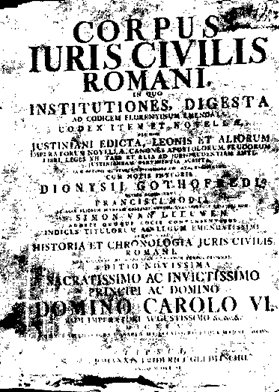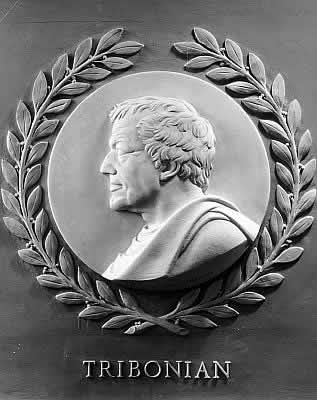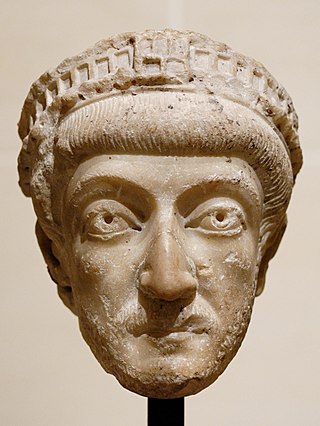Legal scholar
The compiler of the eponymous Codex Hermogenianus, which collects imperial laws of the years AD 293–94, has long been identified with Hermogenianus, author of the six-book Iuris epitomae (Summaries of the law), a synopsis of classical legal thought. [2] This manual, which followed the arrangement of the Praetor's Edict, [3] survives in 106 excerpts in Justinian's Digest or Pandects. [4] The excerpts are reassembled according to an approximation of their original order in Otto Lenel's Palingenesia and an English translation can be constructed by reference to Watson's edition of the Digest. [5] It is clear from his last place in the index to the Florentine Digest, that Hermogenian belonged to the last generation of jurists exploited by Justinian's compilers. References to plural principes and imperatores in several Digest extracts from the Iuris epitomae are certainly consistent with a tetrarchic date. [6] It is probably on this work that his subsequent high reputation was based; the fifth-century author Coelius Sedulius calls Hermogenian a doctissimus iurislator ('most learned relator of the law') and it is probably of the Iuris epitomae (rather than the Codex) that the same author claims that he produced three editions. [7] By analysing the style of the surviving extracts of the Iuris epitomae Tony Honoré has identified Hermogenian also as the drafter of the emperor Diocletian's rescripts (replies to petitions) from the beginning of AD 293 to the end of 294, a task that would have been the job of the emperor's (procurator) a libellis or magister libellorum (master of petitions). These rescripts formed the core of his compilation of imperial laws, the single-book codex that bore his name, which was perhaps designed to function as a supplement to the Codex Gregorianus that itself had gathered up material from as far back as the emperor Hadrian. Certainly, the two works are closely linked in subsequent citations, the Hermogenian always after the Gregorian. [8]
Public servant
More recently the legal scholar has been identified with the Aur(elius) Her[mog]enianus, revealed as co-author with his senior colleague as praetorian prefect, Julius Asclepiodotus, of an inscribed dedication to Constantius as Caesar (AD 293/305), unearthed at Brixia (modern Brescia) in northern Italy in 1983. [9] At this stage, given his title vir eminentissimus (in contrast to his colleague's clarissimus), Hermogenian still belonged to the equestrian order. As happened to a number of senior equestrian prefects of the period, [10] at some point subsequently during Diocletian's reign, he was promoted to the senate, as witnessed by his tenure of the senatorial post of proconsul Asia, in which capacity he put up a dedication to Diocletian or his colleague Maximian at Ilium (Troy) sometime before 305. [11]
Benet Salway suggests identifying Hermogenianus with the Aurelius Hermogenes who served as praefectus urbi of Rome in 309–310, citing the possibility of a corruption in the text of the Chronograph of 354 . [12]

Diocletian, nicknamed "Jovius", was Roman emperor from 284 until his abdication in 305. He was born Diocles to a family of low status in the Roman province of Dalmatia. Diocles rose through the ranks of the military early in his career, eventually becoming a cavalry commander for the army of Emperor Carus. After the deaths of Carus and his son Numerian on a campaign in Persia, Diocles was proclaimed emperor by the troops, taking the name Diocletianus. The title was also claimed by Carus's surviving son, Carinus, but Diocletian defeated him in the Battle of the Margus.

The Corpus JurisCivilis is the modern name for a collection of fundamental works in jurisprudence, issued from 529 to 534 by order of Byzantine Emperor Justinian I. It is also sometimes referred to metonymically after one of its parts, the Code of Justinian.

Ulpian was a Roman jurist born in Tyre. He moved to Rome and rose to become considered one of the great legal authorities of his time. He was one of the five jurists upon whom decisions were to be based according to the Law of Citations of Valentinian III, and supplied the Justinian Digest about a third of its contents.

Tribonian was a notable Byzantine jurist and advisor, who during the reign of the Emperor Justinian I, supervised the revision of the legal code of the Byzantine Empire. He has been described as one of the wisest collaborators of Emperor Justinian.

The Digest, also known as the Pandects, was a compendium or digest of juristic writings on Roman law compiled by order of the Byzantine emperor Justinian I in 530–533 AD. It is divided into 50 books.

The Codex Theodosianus was a compilation of the laws of the Roman Empire under the Christian emperors since 312. A commission was established by Emperor Theodosius II and his co-emperor Valentinian III on 26 March 429 and the compilation was published by a constitution of 15 February 438. It went into force in the eastern and western parts of the empire on 1 January 439. The original text of the codex is also found in the Breviary of Alaric, promulgated on 2 February 506.

The Dominate, also known as the late Roman Empire, is the despotic form of imperial government of the late Roman Empire. It followed the earlier period known as the Principate. Until the empire was reunited in 313, this phase is more often called the Tetrarchy.

Otto Lenel was a German Jewish jurist and legal historian. His most important achievements are in the field of Roman law.
A rescript is an public government document. More formally, it refers to such a document issued not on the initiative of the author, but in response to a question posed to the author. The word originates from replies issued by Roman emperors to such questions and is also used in modern legal terminology and the Papal curia.
Julius Paulus, often simply referred to as Paul in English, was one of the most influential and distinguished Roman jurists. He was also a praetorian prefect under the Roman Emperor Alexander Severus.
The Codex Gregorianus is the title of a collection of constitutions of Roman emperors over a century and a half from the 130s to 290s AD. It is believed to have been produced around 291–4 but the exact date is unknown.
The Codex Hermogenianus is the title of a collection of constitutions of the Roman emperors of the first tetrarchy, mostly from the years 293–94. Most of the work is now lost. The work became a standard reference in late antiquity, until it was superseded by the Breviary of Alaric and the Codex Justinianeus.

In the Late Roman Empire, usually dated 284 AD to 602 AD, the regional governance district known as the Roman or civil diocese was made up of a grouping of provinces each headed by a Vicarius, who were the representatives of praetorian prefects. There were initially twelve dioceses, rising to fourteen by the end of the 4th century.

Simon Corcoran is a British ancient historian and lecturer in ancient history within the School of History, Classics and Archaeology, Newcastle University.
The gens Anicia was a plebeian family at ancient Rome, mentioned first towards the end of the fourth century BC. The first of the Anicii to achieve prominence under the Republic was Lucius Anicius Gallus, who conducted the war against the Illyrians during the Third Macedonian War, in 168 BC.
The Novellae Constitutiones, or Justinian's Novels, are now considered one of the four major units of Roman law initiated by Roman emperor Justinian I in the course of his long reign. The other three pieces are: the Codex Justinianus, the Digest, and the Institutes. Justinian's quaestor Tribonian was primarily responsible for compiling these last three. Together, the four parts are known as the Corpus Juris Civilis. Whereas the Code, Digest, and Institutes were designed by Justinian as coherent works, the Novels are diverse laws enacted after 534 that never were officially compiled during his reign.

The law school of Berytus was a center for the study of Roman law in classical antiquity located in Berytus. It flourished under the patronage of the Roman emperors and functioned as the Roman Empire's preeminent center of jurisprudence until its destruction in AD 551.

The Institutes is a component of the Corpus Juris Civilis, the 6th-century codification of Roman law ordered by the Byzantine emperor Justinian I. It is largely based upon the Institutes of Gaius, a Roman jurist of the second century A.D. The other parts of the Corpus Juris Civilis are the Digest, the Codex Justinianus, and the Novellae Constitutiones.

The Code of Justinian is one part of the Corpus Juris Civilis, the codification of Roman law ordered early in the 6th century AD by Justinian I, who was Eastern Roman emperor in Constantinople. Two other units, the Digest and the Institutes, were created during his reign. The fourth part, the Novellae Constitutiones, was compiled unofficially after his death but is now also thought of as part of the Corpus Juris Civilis.












